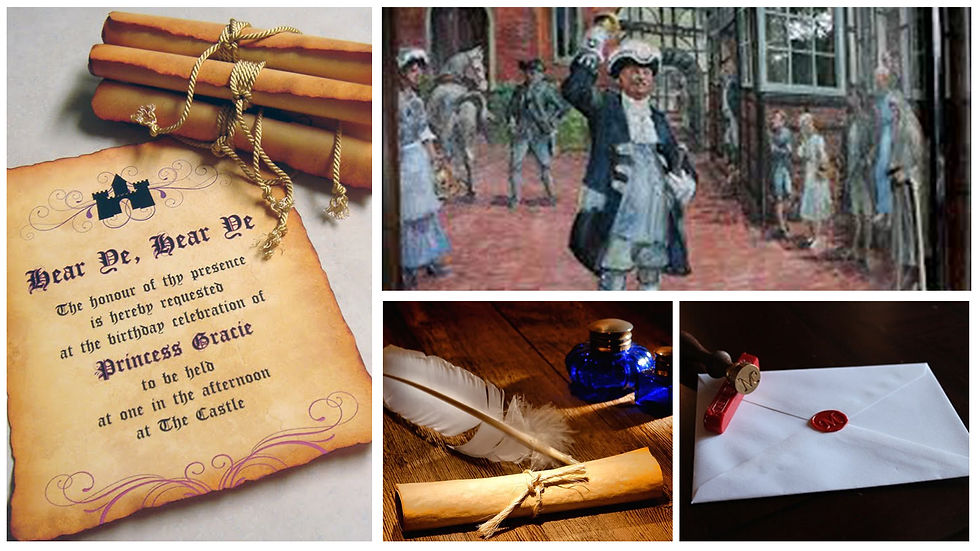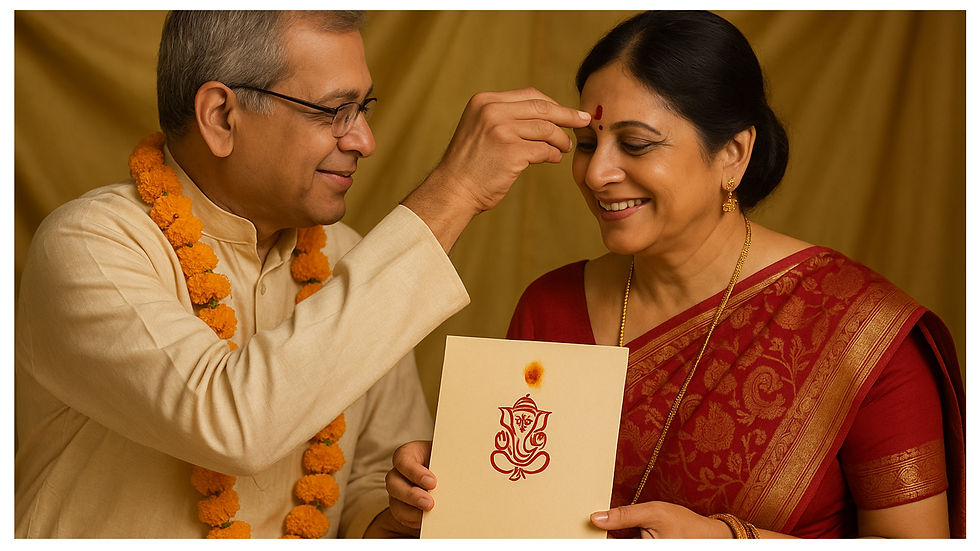History of Wedding Invitations
- The Great Indian Studio

- Jun 18
- 4 min read
Updated: Jul 3
The Social Nature of Weddings
As social animals, we need to share our emotions and important life events with our near and dear ones. Since the beginning, social gatherings have been a prerequisite for cultural events, especially one as auspicious as a wedding. After all, every day is not Sunday! Let's get to know about the history of wedding invitation.
The Birth of Wedding Invitations in India
The tradition of addressing and dispatching wedding invitation cards sprouted in India in the 19th century. The idea was adopted from the British culture, and initially, the cards were even cloned from Victorian invitation cards. The Indian royalty, eager to share colonial practices and etiquette with the West, ardently took to printing wedding invitation cards.

Before Cards: The Town Crier and the Aristocratic Way
An antecedent to the printed wedding cards was the Town Crier. He used to walk around the town announcing the wedding details with his voice blaring through the air! Thus, the weddings had negligible privacy, and whoever heard the invitation was a welcome guest. When illiteracy was widely pervasive in the Middle Ages, the custom of sending written wedding invitations cropped up among the aristocrats and imperialists. Wealthy families would recruit monks to design the wedding cards using their calligraphic skills. They were reported to have carried the Coat of Arms or personal crest of the individual. The envelopes were sealed with wax.

The Printing Press Revolution
The printing press has been instrumental in the printing of wedding cards. That is when the practice of announcing weddings in the newspaper was initiated in Western culture. It eventually became prevalent in 1642 onwards after the invention of metal-plate engraving. Therefore, high-quality wedding invitations and stationery turned out to be affordable even for the middle class. As usual, the advancement in technology made things easier. The invention of Lithography during the Industrial Revolution made the intricate designing of wedding invitations possible. This waltzed, plush and ritzy wedding stationery is in vogue. As its popularity prevailed, the printing technique of Thermography emerged. This allowed raised print to be used on stationery, thereby curbing the time and toil spent on engraving.

A Purpose Beyond Invitation
People need to know that the fortunate among them are about to get a life partner, you know, as the hearsay goes: neighbour’s envy, owner’s pride! The purpose was to inform the guests who were getting married when the marriage was scheduled, the venue for the event, and the programs for the respective days. Conventionally, the parents of the bride and groom are obliged to cordially invite close relatives and people of eminence in their social circle. Earlier, sweets or fruits were given away as gift tokens along with the invitation card. There was no hint of extravagant lavishness visible in the cards till the 1950s. If you are curious as to why the case was such, you would be amused to know that the style of the invitation cards corresponded with the large-scale aversion towards unnecessary spending habits. The immensely rich families were also humbled in an attempt to avoid income tax raids!

The Simplicity of the Past
Indian Wedding Invitations are the insignia for the celebration itself. The rich cultural heritage and sentiments are exuded via the tiniest details of a wedding. The ornate traditions are accentuated with profusely designed ethnic wedding invitations enriched with bona fide warmth. They are not only instrumental in inviting the guests over but also in bringing events and respective themes to the limelight. It conveys the first impression of the holy matrimony. The rich and sometimes gaudy designs on the cards turn out to be strikingly attention-grabbing. The formal details such as the occasion, time, date, venue, names of the bride and groom, and their parents, etc., are mentioned.

The Soul of Indian Wedding Invitations
The cards often have artistic patterns along with imprints of Indian Gods and Goddesses whom they place their faith in. The divine, religious deities are of optimum significance and are highly regarded in an Indian matrimonial ceremony. Various religious symbols such as the Varmala, Doli, Swastika, Dholak, footprints of the Goddess Lakshmi, and Om etc. are printed. Even verses from holy Sanskrit mantras are quoted on the card or envelope. These are deemed lucky and sacred by the natives and are believed to bring the blessings of the universe to the bride and groom. Before the cards are dispatched for distribution, Hindus usually dab a little sandalwood paste or turmeric paste on the card

Traditions in Card Distribution
Often, the hosts even place a route map to the venue inside the envelope (behind or inside the card)! The distribution of cards begins with the exchange of wedding invitations between the bride and groom's parents. The application of tilak using ‘kumkum’ or saffron powder on the forehead marks the beginning of the auspicious occasion.

The Rise of Digital Invitations
To keep up with the latest trends, digital invitations are the way to go. All you need is to hire artistic graphic designers (or contact The Great Indian Studio) who can envision your concept and bring it to life. These invitations are hassle-free, time-saving, budget-friendly, and of course, eco-friendly, as they save all that paper! You also save a lot of time otherwise spent on writing, sealing, and dispatching physical cards. Plus, you avoid the wrath of grumpy relatives who expect the bride's or groom’s parents to visit personally for a formal invitation—a tradition that's often inconvenient during the busy preparation period. So, the next time you’re involved in a wedding, share this lovely idea—because everyone deserves to dwell in happiness ever after!


Comments